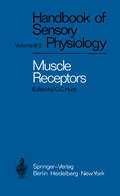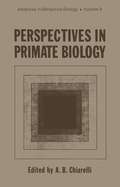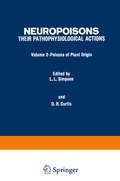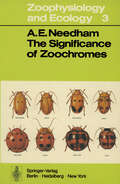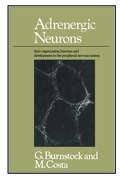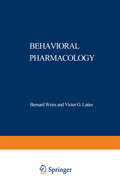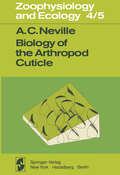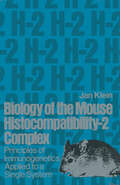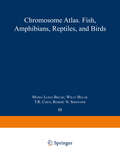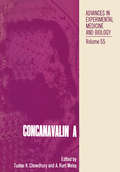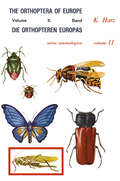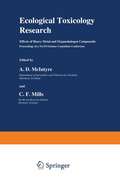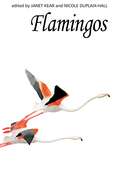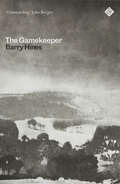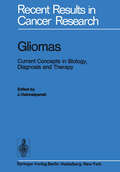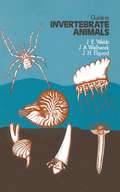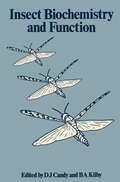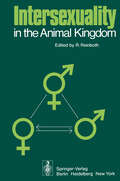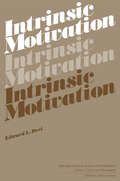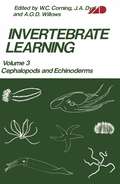- Table View
- List View
Muscle Receptors (Handbook of Sensory Physiology #3 / 2)
by D. Barker C.C. Hunt A.K. McIntyreThis section will consider the structure and function of muscle receptors, as well as the central nervous system mechanisms with which they are concerned. In volume I of this Handbook, receptor mechanisms are discussed in detail. Also, the crustacean stretch receptor and the frog muscle spindle have been considered. The present section will be concerned with vertebrate muscle receptors with an emphasis on mammals. Muscle receptors provide interesting examples of specialized mechanorecep tors. The muscle spindle is a striking case of a receptor which is regulated in its function by the central nervous system in efferent neurons. Muscle receptors have long been known to playa crucial role in the reflex regulation of movement. In recent years it has become apparent that these receptors are also important in sensory phenomena such as the perception of position and movement. St. Louis, July 1974 c.c. HUNT Contents Chapter I The Morphology of Muscle Receptors. By D. BARKER. With 99 Figures . . . . . . . . . . . . . . . .. 1 Chapter II The Physiology of Muscle Receptors. By C.C. HUNT. With 21 Figures . . . . . . . . . . . . . . . . . 191 Chapter III Central Actions of Impulses in Muscle Afferent Fibres. By A. K. McINTYRE. With 8 Figures 235 Author Index 289 Subject Index 299 List of Contributors BARKER, David Department of Zoology, University of Durham, Science Laboratories, South Road, Durham DH1 3LE, Great Britain HUNT, Carlton C. Department of Physiology and Biophysics, Washington University, School of Medicine, 660 South Euclid Avenue, St. Louis, Mo. 63110, USA McINTYRE, A. K.
Perspectives in Primate Biology (Advances in Behavioral Biology #9)
by A. B. ChiarelliThe present volume is the result of a NATO Advanced Study Institute held in Montaldo, Turin (Italy), between the 7 and 19 June 1972. The aim of the Study Institute has been the development of a general philosophy for the science of Primatology. Lecturers were selected from those scientists deeply involved and interested in this field. The course intended to serve students and researchers using primates in medical and biological research, but especially those interested in the natural history of the group and in human biology. In the past the study of primates was largely limited to deter mine the origin of the human species. Today, however, interest in them extends far beyond this narrow focus. In terms of both prac tical human purposes and theoretical interests, the study of primate biology and behaviour is of ever increasing importance. Their close comparative relationships with man has proved of such great value to human biology and medicine that their numbers and kinds are quickly dwindling. For this reason, one of the main focuses of the A.S.I. was on their reproductive biology and conservation. During the meeting days a broad series of lectures on specific topics of comparative anatomy, physiology, endocrinology, repro ductive physiology, genetics and molecular biology, cytogenetics and behaviour were delivered by leading primatologists.
Poisons of Plant Origin
by Lance L. Simpson David R. CurtisIn Volume 1 of this series, attention was focused on neuropoisons of animal origin. In the present volume, attention has been shifted to poisons of plant origin. In both cases, we have attempted to identify those poisons for which there is a large measure of clinical or research interest. Our efforts in compiling the series have been aided by three groups of individuals. First, we are grateful to the investigators who contributed chapters. Their labors are the substance of this two-volume work. Second, we are pleased to acknowledge the support of Mr. Seymour Weingarten and Plenum Press in our project. And third, we have been immeasurably aided by our assistants, Mrs. Ruby Hough in New York City and Mrs. Helena Walsh in Canberra. To all these persons, we are indebted. Dr. Lance L. Simpson Dr. David R. Curtis New York City Canberra vii Contents Chapter 1 Reserpine 1 by Theodore A. Slot kin I. Introduction .......................................... .
Reproductive Behavior (Advances in Behavioral Biology #11)
by William Montagna and William A. SadlerSexual compatibility between male and female partners is in dispensable to normal and successful fertilization in mammals. Thus, the genes from males and females whose sexual behavior is characterized by awkwardness, ineptness, and miscues are elimi nated from the gene pool of the species. In human societies, this compatibility is not always evident; and the behavior that precedes and accompanies copulation and fertilization is exceed ingly complex and affected by many variables. As in most other species of animals, the entire repertoire of reproductive behavior of man is not well understood by man. When viewed, discussed, or reported, the topic is too often and most unfortunately regarded as an amalgam of emotion, mysticism, and biology. In the past, such emotion-charged approaches to the biologi cal fact of reproduction did much to obfuscate the subject; and as a result, much of the array of hormonal, neural, psychological, and social variables that control and insure the successful repro duction of the human species remains even now in Victorian ignor ance. But with the recent rash of books and scientific treatises on the subject, some progress has been made in elucidating human reproduction and associated sexual behavior. However, so entrench ed are some of our social taboos that the danger still lurks of equating social acceptance of the words with an understandin- all too lacking--of the process to which they refer.
The Significance of Zoochromes (Zoophysiology #3)
by A.E. NeedhamAs the title indicates, the theme of this book is the functions of biochromes in animals. Recent works on zoochromes, such as those of D. L. Fox (1953), H. M. Fox and VEVERS (1960) and VUILLAUME (1969), have been concerned primarily with the chemical nature and the taxonomic distribution of these materials, and although function has been considered where relevant this has not been the centre of interest and certainly not the basis for the arrangement of the subject matter. Functional significance is a profitable focus of interest, since it is the one theme which can make biochromatology a discrete and integral subject, and because it is the main interest in all biological fields. At present chromatology seems to be a particularly schizoid subject since it is clear that in metabolic functions biochromes are acting in a chemical capacity whereas integumental pigments function mainly biophysically, in neurological and behavioural contexts. It is profitable to attempt an integration by studying the functions of as many chromes as possible, from all aspects.
Adrenergic Neurons: Their Organization, Function and Development in the Peripheral Nervous System
by Geoffrey Burnstock CostaBiology of Brain Dysfunction: Volume 3
by Gerald E. GaullThe growth of neurochemistry. molecular biology, and biochemical genetics has led to a burgeoning of new information relevant to the pathogenesis of brain dysfunction. This explosion of exciting new information is crying out for collation and meaningful synthesis. In its totality, it defies systematic summa tion, and, of course, no one author can cope. Thus invitations for contributions were given to various experts in areas which are under active investigation, of current neurological interest, and pregnant. Although this project is relatively comprehensive, by dint of size. other topics might have been included; the selection was solely my responsibility. I believe systematic summation a virtual impossibility-indeed, hardly worth the effort. The attempt to assemble all of the sections involved in a large treatise with multiple authors inevitably results in untoward delays due to the difference in the rate at which various authors work. Therefore, the following strategy has been adopted: multiple small volumes and a relatively flexible format, with publication in order of receipt and as soon as enough chapters are assembled to make publication practical and economical. In this way, the time lag between the ideas and their emergence in print is the shortest.
Biology of the Arthropod Cuticle (Zoophysiology #4/5)
by A.C. NevilleMention the words 'arthropod cuticle' to most biologists and they usually provoke a glazed expression. This is because the cuticle is commonly regarded as an inert substance. It is hoped that this book will dispel this fallacy. The study of cuticle in its proper context now involves many of the wider aspects of biology which are currently in vogue (e. g. how a hormone like ecdyson induces a specific enzyme like dopa decarboxylase; the unsolved major problem of cell gradient and polarity; the involvement of cyclic AMP in hormonal mechanisms; the extra cellular control of cuticular enzymes, of the mechanical proper ties of cuticle structural proteins, and of the orientation of fibrous molecules; and the relation of chromosome puffing to the synthesis of specific proteins). Studies on cuticle demand a variety of techniques, and examples of the following are illustrated in this book (fluorescence, phase contrast, polariza tion and Nomarski interference microscopy; infrared absorp tion; transmission and scanning electron microscopy; autora diography analyzed by electron microscopy; negative staining in the electron microscope; optical diffraction, high angle X-ray diffraction, low angle X -ray diffraction and selected area electron diffraction). I am well aware that the biophysical parts of this book are less incomplete than other aspects. A developmental biologist or a biochemist would have further elaborated other parts ofthe subject matter. Only one previous author, RICHARDS (1951)hasdevoted a book to arthropod cuticle.
Biology of the Mouse Histocompatibility-2 Complex: Principles of Immunogenetics Applied to a Single System
by J. de KleinSomewhere I heard a story of a bridge and a painter. The bridge was enormous and was made all of metal, and the painter's job was to keep it from rusting. He would start at one end and slowly proceed, day by day, month by month, toward the other end, painting the bridge. But no sooner would he finish with the painting than the bridge would begin to rust again. The rust, too, would start at one end and slowly proceed toward the other end, systematically destroying the painter's endeavor. And so the painter would return to where he had started, and begin painting again, slowly proceeding toward the other end of the bridge, always just one step ahead of the rust. And if the story is true, the painter might still be painting that bridge-a modern Sisyphus! During the writing of this book, the story of the painter and his bridge kept coming to mind. The field the book covers has been developing so rapidly that, like the painter, I too had to return to where I had started and fight the rust of obsolescence. But unlike the painter, I had a deadline to meet, which constituted a point of no return. And so, sending off this manuscript, I have no choice but to watch the fruits of my endeavor be overtaken by the rust.
Chromosome Atlas: Volume 3
by Kurt Benirschke Tao C. Hsu M. L. Becak W. Becak F. L. Roberts Shoffner E. P. VolpeConcanavalin A (Advances in Experimental Medicine and Biology #55)
by Tushar ChowdhuryConcanavalin A (Con A), a plant lectin, has become an object of extensive research not only for the biochemist, but also for the bi ologist, biophysicist, pathologist, immunologist and others. On April 19-20, 1974 a group of scholars from four continents met on the campus of the University of Oklahoma for an International Symposium on Con A. This volume contains all lectures presented by the invited speakers on this occasion, as well as the abstracts for all shorter technical papers which were presented. Further, the edi tors invited additional contributions from a few selected laboratories to cover the areas not covered in the symposium itself. This volume then reports the present status of research with Con A. In a sense it is encyclopedic and should be a useful reference tool to the worker in this field. The newcomer to this area will find that a careful study of this book will bring him up-to-date with the latest techniques, ap proaches and the "state of the art" in this specialized area of re search, as well as with traps and ensnarements in which he need not get entangled again. Starting at the molecular level and advancing from there to the organismic level as well as to a number of highly specialized areas, this volume presents the most complete survey of research findings with Con A available today. The editors wish to acknowledge the generous financial support provided by the University of Oklahoma through its President, Dr.
Cytochromes P-450 and b5: Structure, Function, and Interaction (Advances in Experimental Medicine and Biology #58)
by David CooperP-450 has in common with our nation that it can call Phila delphia its hometown. Yet there are differences, too. The U. S. A. was born and named in this city. P-450 was first recog nized here -- an odd CO-combining pigment without family or func tion. Japanese workers identified it as an unusual member of the cytochrome family. Finally, in Philadelphia, its biological func tion was established and its growth to a global power initiated. Since discovery of its function as terminal oxidase of the 21-steroid hydroxylase system of adrenocortical microsomes, P-450 has proved to play the same role in a wide variety of other mixed function oxidase systems involved in biosynthesis and catabolism of specific cell or body components as well as in the metabolism of foreign substances entering organisms. P-450-like oxygenating enzymes appear to be fundamental cellular constituents in most forms of aerobic organisms. Activation of molecular oxygen and incorporation of one of its atoms into organic compounds as cata lyzed by P-450 enzymes are reactions of vital importance not only for biosynthesis and degradation of steroid hormones necessary for sustaining life, but also for metabolic activation or inactivation of foreign agents such as drugs, food preservatives and additives, insecticides and carcinogens. Moreover, P-450 linked enzyme sys tems can either be induced or suppressed by these agents with significant biological consequences.
Die Orthopteren Europas II / The Orthoptera of Europe II: Volume II (Series Entomologica #11)
by A. HarzDog Training (Collins Need to Know?)
by CollinsThis one-stop practical guide will show you how to transform your dog into the perfect companion.
Ecological Toxicology Research: Effects of Heavy Metal and Organohalogen Compounds
by A. D. McIntyre C. F. MillsThe Conference on the Ecotoxicity of Heavy Metals and Organohalogen Com pounds was held under the auspices of the NATO Science Committee as part of its continuing effort to promote the useful progress of science through international cooperation. Science Committee Conferences are deliberately designed to focus atten tion on unsolved problems, with invited participants providing a variety of complementary expertise. Through intensive group discussion they seek to reach a consensus on assessments and recommendations for future research emphases, which it is hoped will be of value to the larger scientific commu nity. The subjects treated in previous Conferences have been as varied as science itself-e.g., computer software, chemical catalysis, oceanography, and materials and energy research. This volume presents an account of a meeting which evolved from studies within the Science Committee's advisory panel on Eco-Sciences. Environmental monitoring of toxic substances from industrial and agricultural sources is pro ducing a growing volume of data on the quantities of such substances in terres trial and aquatic milieus. Before this information can be used to assess biological effects, knowledge is required of the chemical form of the pollutants, the mecha nisms by which they enter and move through organisms, their concomitant transformations, the nature of the toxic reactions within tissues, and the way in which the physiology and behavior of individuals is affected.
Enzyme Induction (Basic Life Sciences #6)
by Dennis ParkeOur present concepts ofthe regulation of enzyme activity in the cell have been largely based on the extensive body of work which has been carried out with micro-organisms. A distinction between constitutive and adaptive enzymes had already been made well before World War II and work on enzyme adaptation, both in yeast and bacteria, was done by several workers, especially Marjorie Stephenson and her group in Cambridge in the 1930s. In studies starting about 1947 Stanier demonstrated that the oxidation of aromatic compounds by species of Pseudomonas involved the coordinate and sequential induction of a group of enzymes concerned in the orderly catabolism of a substrate which acted as the inducer. The investigations of Umbarger and of Pardee, both in 1956, established the principle, which is now firmly established for almost all anabolic reaction chains, that the first 'committed' step in a biosynthetic pathway is sensitive to feedback control by the final product of the particular reaction sequence. This control can be exercised in two ways. It can either act on the rate of formation of the enzyme or it can affect the activity of the latter without altering the concentration of the enzyme.
Flamingos (Poyser Monographs)
by Janet Kear Nicole Duplaix-HallThis collection of papers on the flamingos was one of the earliest Poyser monographs. Janet Kear was one of the co-editors of this work.
The Gamekeeper (G - Reference,information And Interdisciplinary Subjects Ser.)
by Barry HinesGeorge Purse is an ex-steelworker employed as a gamekeeper on a ducal country estate. He gathers, hand-rears and treasures the birds to be shot at by his wealthy employers. He must ensure that the Duke and his guests have good hunts when the shooting season comes round on the Glorious Twelfth; he must ensure that the poachers who sneak onto the land in search of food do not.Season by season, over the course of a year, George makes his rounds. He is not a romantic hero. He is a labourer, who knows the natural world well and sees it without sentimentality.Rightly acclaimed as a masterpiece of nature writing as well as a radical statement on work and class, The Gamekeeper was also, like Hines’s A Kestrel for a Knave (Kes), adapted by Hines and filmed by Ken Loach, and it too stands as a haunting classic of twentieth-century fiction.
Gliomas: Current Concepts in Biology, Diagnosis and Therapy (Recent Results in Cancer Research #51)
by Javad HekmatpanahWhen I was asked by the Cancer Teaching Committee of the University of Chicago to set up a Symposium on Brain Tumors, I welcomed the opportunity to do so. But I felt that "Brain Tumors" was far too broad a subject to cover in a day and a half meeting. Furthermore, during the past decade, there have been a great many papers and symposiums on technical advancements in the treatment of benign brain tumors. On the other hand, while gliomas make up somewhere around 50% of all brain tumors, there have certainly been far fewer communications about them. For this reason I thought that it would be highly valuable to invite some of the leading investigators to share with us their experience with gliomas. The hope was to learn the current concepts about these tumors biologically and therapeutically, specifically to find out what we are doing and where we are going in these respects. Naturally all aspects could not be covered. Nevertheless, it was a widely expressed opinion by the speakers that they too learned while they came to teach. It is therefore hoped that the publication of their works and ideas through this mono graph will also be useful for the reader. Most of the manu scripts were handed in at the time of the Symposium, and a few were sent later. Except for minor editorial changes the words are entirely those of the speakers and authors.
Insect Biochemistry and Function
by David John Candy B. A. KilbyThere has been a considerable upsurge in interest in insect bio chemistry and physiology in recent years and this has been reflected in a notable expansion in the number of original papers in this field. Whereas insect physiology has tended to receive ample attention from reviewers, the same has not always been true for the more of insect research. This book is a venture to help biochemical aspects redress the balance. No attempt has been made to cover all aspects of insect biochemistry, but rather a few topics have been selected which seemed to us to merit a review at the present time. One reason for this increased interest in insect biochemistry is perhaps the growing realization that insects can be very useful organisms to act as model systems for the experimental study of general biochemical principles. One remembers, for instance, that Keilin's perceptive observations on the flight muscles of living bees and wax moths led to his discovery of the cytochromes. The fundamental unity of biochemistry has long been accepted as a dogma by the faithful and the insect kingdom provides no exception to it. The main biochemical processes in insects are being revealed as essentially the same as in other life forms but, as so often found in comparative biochemistry, there are interesting variations on the central theme.
Intersexuality in the Animal Kingdom
by R. ReinbothWhen Richard Goldschmidt' coined the term "intersexuality" in 1915, he intended it to apply to normally dioecious species which exhibit some kind of mixture between male and female characters. However, as knowledge of the bewildering variability present in the sexual orga nization of members of the animal kingdom has increased, the original meaning of the word has changed. Today many authors define inter sexuality as "the presence of both male and female characteristics, or of intermediate sexual characteristics, in a single individual".2 This more extensive and widely accepted concept justifies the title of our book •. Among all the anatomical and physiological features of living organisms the reproductive system has a unique importance for the perpetuation of the species. Conversely, reproductive processes are of little or no account for the viability of the individual. Therefore, within the framework of general biology reproduction has all too often been looked at solely from the point of view of genetics. Lively discussions about genotypic versus phenotypic sex determination long dominated the sci entific literature on sexuality in animals; this one-sided emphasis has tended to obscure many important facets of an organism's ability to reproduce. Recent developments in current biological research have brought the classic problem of sex differentiation into focus again, and the rapid progress being made in comparative endocrinology has added a new di mension to the study of reproductive biology.
Intrinsic Motivation (Perspectives in Social Psychology)
by Edward L. DeciAs I begin to write this Preface, I feel a rush of excitement. I have now finished the book; my gestalt is coming into completion. Throughout the months that I have been writing this, I have, indeed, been intrinsically motivated. Now that it is finished I feel quite competent and self-determining (see Chapter 2). Whether or not those who read the book will perceive me that way is also a concern of mine (an extrinsic one), but it is a wholly separate issue from the intrinsic rewards I have been experiencing. This book presents a theoretical perspective. It reviews an enormous amount of research which establishes unequivocally that intrinsic motivation exists. Also considered herein are various approaches to the conceptualizing of intrinsic motivation. The book concentrates on the approach which has developed out of the work of Robert White (1959), namely, that intrinsically motivated behaviors are ones which a person engages in so that he may feel competent and self-determining in relation to his environment. The book then considers the development of intrinsic motiva tion, how behaviors are motivated intrinsically, how they relate to and how intrinsic motivation is extrinsically motivated behaviors, affected by extrinsic rewards and controls. It also considers how changes in intrinsic motivation relate to changes in attitudes, how people attribute motivation to each other, how the attribution process is motivated, and how the process of perceiving motivation (and other internal states) in oneself relates to perceiving them in others.
